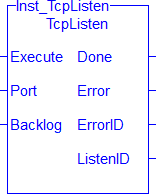 TcpListen
TcpListen
Description
This function block creates a new socket by performing the bind and listen operations using default TCP settings. You will have to use the TcpClose function block to release the socket returned by TcpListen.

Figure 7-223: The TcpListen function block
Related Functions
TcpAccept, TcpBinReceive, TcpBinSend, TcpClose, TcpConnect, TcpIsConnected, TcpIsValid, TcpReceive, TcpSend
Arguments
Input
| Execute | Description | On the rising edge |
| Data Type | BOOL | |
| Range | 0, 1 | |
| Unit | N/A | |
| Default | — | |
| Port | Description | The network port to use |
| Data Type | DINT | |
| Range | N/A | |
| Unit | N/A | |
| Default | — | |
| Backlog | Description | The size of the queue for pending connections. If more than Backlog number of connection attempts are made prior to a TcpAccept call, then the controller may refuse the connections. |
| Data Type | DINT | |
| Range | N/A | |
| Unit | N/A | |
| Default | — |
Output
| Done | Description | If TRUE, then the command completed successfully |
| Data Type | BOOL | |
| Error | Description | If TRUE, an error has occurred |
| Data Type | BOOL | |
| ErrorID | Description | Indicates the error if Error output is set to TRUE. See the table in Search IndexFile and TCP/IP Function Block ErrorID Output |
| Data Type | DINT | |
| ListenID | Description | The ID of the new listen socket |
| Data Type | UDINT |
Example
Structured Text
(* TcpListen example *)
CASE StepCounter OF
0:
Inst_TcpListen(TRUE, 1234, 2);
StepCounter := StepCounter + 1;
1:
Inst_TcpListen(TRUE, 1234, 2);
IF Inst_TcpListen.Done THEN
MyListenID := Inst_TcpListen.ListenID;
Inst_TcpListen(FALSE, 0, 0);
StepCounter := StepCounter + 1;
END_IF;
END_CASE;






